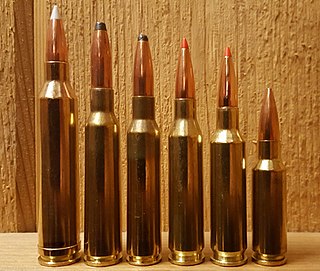
The .338 Lapua Magnum is a rimless, bottlenecked, centerfire rifle cartridge. It was developed during the 1980s as a high-powered, long-range cartridge for military snipers. Due to its use in the War in Afghanistan and the Iraq War, the cartridge has become widely available.

The .223 Remington is a rimless, bottlenecked, centerfire rifle cartridge. It was developed in 1957 by Remington Arms and Fairchild Industries for the U.S. Continental Army Command of the United States Army as part of a project to create a small-caliber, high-velocity firearm. The .223 Remington is considered one of the most popular common-use cartridges and is currently used by a wide range of semi-automatic and manual-action rifles.
The Sporting Arms and Ammunition Manufacturers' Institute is an association of American manufacturers of firearms, ammunition, and components. SAAMI is an accredited standards developer that publishes several American National Standards that provide safety, reliability, and interchangeability standards for commercial manufacturers of firearms, ammunition, and components. In addition, SAAMI publishes information on the safe and responsible transportation, storage, and use of those products.

The .308 Winchester is a smokeless powder rimless bottlenecked rifle cartridge widely used for hunting, target shooting, police, military, and personal protection applications globally. It is similar, but not identical, to the 7.62×51mm NATO cartridge.

The .303 British or 7.7×56mmR, is a .303-inch (7.7 mm) calibre rimmed rifle cartridge. The .303 inch bore diameter is measured between rifling lands as is the common practice in Europe which follows the traditional black powder convention.

6.5×55mm Swedish, also known simply as 6.5×55mm, 6.5x55 SE, 6.5x55 Swede, or in its native military as 6.5 mm patron m/94, meaning "6.5 mm cartridge model 94", referring to 1894, is a first-generation smokeless powder rimless bottlenecked rifle cartridge. The cartridge has most users in the Scandinavian countries, where it is known as the 6,5×55 or just "the 6,5".

The gauge of a firearm is a unit of measurement used to express the inner diameter of the barrel.

The 7.92×57mm Mauser is a rimless bottlenecked rifle cartridge. The 7.92×57mm Mauser cartridge was adopted by the German Empire in 1903–1905, and was the German service cartridge in both World Wars. In its prime, the 7.92×57mm Mauser cartridge was one of the world's most popular military cartridges. In the 21st century it is still a popular sport and hunting cartridge that is factory-produced in Europe and the United States.
The 7.62×45mm is a rimless bottlenecked intermediate rifle cartridge developed in Czechoslovakia. It is fired by the Czech Vz. 52 rifle, Vz. 52 light machine gun, and ZB-53 machine gun. The cartridge was later dropped from use when the Czech converted to the standard 7.62×39mm Warsaw Pact cartridge of the Soviet Union. Its muzzle velocity and muzzle energy are slightly higher than that of the 7.62×39mm cartridge, and is on par with the .30-30 Winchester cartridge, with equivalent projectiles.
A proof test is a form of stress test to demonstrate the fitness of a load-bearing or impact-experiencing structure. An individual proof test may apply only to the unit tested, or to its design in general for mass-produced items. Such a structure is often subjected to loads above those expected in actual use, demonstrating safety and design margin. Proof testing is nominally a nondestructive test, particularly if both design margins and test levels are well-chosen. However, unit failures are by definition considered to have been destroyed for their originally-intended use and load levels.

Overpressure ammunition, commonly designated as +P or +P+, is small arms ammunition that has been loaded to produce a higher internal pressure when fired than is standard for ammunition of its caliber, but less than the pressures generated by a proof round. This is done typically to produce ammunition with higher muzzle velocity, muzzle energy, and stopping power, such as ammunition used for security, defensive, or hunting purposes. Because of this, +P ammunition is typically found in handgun calibers which might be used for paramilitary forces, armed security, and defensive purposes.

The 7mm Remington Magnum rifle cartridge was introduced as a commercially available round in 1962, along with the new Remington Model 700 bolt-action rifle. It is a member of the belted magnum family that is directly derived from the venerable .375 H&H Magnum. The original purpose of the belted magnum concept taken from the .300 H&H Magnum and .375 H&H Magnum, was to provide precise headspace control, since the sloping shoulders, while easing cartridge extraction, were unsuitable for this purpose. Improved cartridge extraction reliability is desirable while hunting dangerous game, in particular when a fast follow-up shot is required. The 7mm Remington Magnum is based on the commercial .264 Winchester Magnum, .338 Winchester Magnum, and .458 Winchester Magnum, which were based on the same belted .300 H&H Magnum and .375 H&H Magnum cases, trimmed to nearly the same length as the .270 Weatherby Magnum.

The 8mm Remington Magnum belted rifle cartridge was introduced by Remington Arms Company in 1978 as a new chambering for the model 700 BDL rifle. The 8mm Remington Magnum's parent case is the .375 H&H Magnum. It is a very long and powerful cartridge that cannot be used in standard length actions, such as those that accommodate the .30-06 Springfield.

The 8×68mm S rebated rim bottlenecked centerfire rifle cartridge was developed in the 1930s by August Schüler of the August Schüler Waffenfabrik, Suhl, Germany as a magnum hunting cartridge that would just fit and function in standard-sized Mauser 98 bolt-action rifles. The bore has the same lands and grooves diameters as the German 7.92×57mm Mauser service cartridge. This is one of the early examples where a completely new rifle cartridge was developed by a gunsmith to fit a specific popular and widespread type of rifle.

The Commission internationale permanente pour l'épreuve des armes à feu portatives, commonly abbreviated C.I.P., is an international organisation which sets standards for safety testing of firearms. As of 2015, its members are the national governments of 14 countries, of which 11 are European Union member states. The C.I.P. safeguards that all firearms and ammunition sold to civilian purchasers in member states are safe for the users.
The 8×64mm S is a rimless bottlenecked centerfire cartridge developed as a military service round for the German Army who never issued it. As is customary in European cartridges the 8 denotes the 8 mm bullet caliber and the 64 denotes the 64 mm (2.52 in) case length.

The 6.5mm Creedmoor (6.5×48mm), designated 6.5 Creedmoor by SAAMI, 6.5 Creedmoor by the C.I.P. or 6.5 CM or 6.5 CRDMR for short, is a centerfire rifle cartridge introduced by Hornady in 2007. It was developed by Hornady senior ballistics scientist Dave Emary in partnership with Dennis DeMille, the vice-president of product development at Creedmoor Sports, hence the name. The cartridge is a necked-down modification of the .30 Thompson Center.
Within firearms, chamber pressure is the pressure exerted by a cartridge case's outside walls on the inside of a firearm's chamber when the cartridge is fired. The SI unit for chamber pressure is the megapascal (MPa), while the American SAAMI uses the pound per square inch and the European CIP uses bar.
Small arms ammunition pressure testing is used to establish standards for maximum average peak pressures of chamberings, as well as determining the safety of particular loads for the purposes of new load development. In metallic cartridges, peak pressure can vary based on propellant used, primers used, charge weight, projectile type, projectile seating depth, neck tension, chamber throat/lead parameters. In shotshells, the primary factors are charge weight, projectile weight, wad type, hull construction, and crimp quality.
The .277 Fury or 6.8×51mm Common Cartridge, is a centerfire rimless bottlenecked rifle cartridge announced by SIG Sauer in late 2019. Its hybrid three-piece cartridge case has a steel case head and brass body connected by an aluminum locking washer to support the high chamber pressure of 80,000 psi (551.6 MPa).












